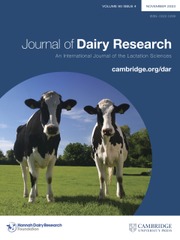No CrossRef data available.
Article contents
Impact of fabricated clove and ginger oil nano-emulsions on the survival of Staphylococcus aureus and Aspergillus flavus in labneh: A fermented model
Published online by Cambridge University Press: 22 October 2025
Abstract
This research paper investigated the potential application of essential oils nano-emulsion after characterization as natural preservatives in the dairy sector, by measuring the minimum inhibitory concentration of ginger and clove oil nano-emulsion along with their impact on the sensory properties, starter culture activity and survivability of some foodborne pathogenic and spoilage microorganisms in fortified laboratory-manufactured labneh. The characterized EOs nano-emulsions exhibited significant antimicrobial effect against the tested microorganisms (Escherichia coli, Salmonella Typhimurium, Staphylococcus aureus, Pseudomonas aeruginosa, and Aspergillus flavus). S. aureus was completely inhibited in labneh fortified with 0.1 µg/mL clove and ginger nano-emulsion in the first and second weeks of the storage period, respectively. While A. flavus count was reduced by 100 and 35% in labneh fortified with 1 µg/mL clove and ginger nano-emulsion, respectively. Nonetheless, the overall acceptability and flavour of the fortified samples revealed scores that were not significantly different from the control samples (P > 0.05). These results were obtained without interfering with the starter culture activity during processing and storage period. In conclusion, the obtained results open a promising avenue for the EOs nano-emulsions application as safe and natural alternative in the dairy industry.
Information
- Type
- Research Article
- Information
- Copyright
- © The Author(s), 2025. Published by Cambridge University Press on behalf of Hannah Dairy Research Foundation.

